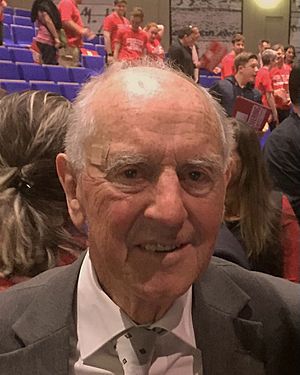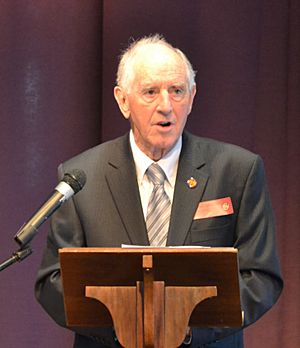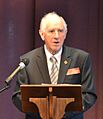John Cain (41st Premier of Victoria) facts for kids
Quick facts for kids
John Cain
|
|
|---|---|

Cain in 2018
|
|
| 41st Premier of Victoria | |
| In office 8 April 1982 – 10 August 1990 |
|
| Monarch | Elizabeth II |
| Governor | Sir Brian Murray Davis McCaughey |
| Deputy | Robert Fordham Joan Kirner |
| Preceded by | Lindsay Thompson |
| Succeeded by | Joan Kirner |
| Leader of the Opposition of Victoria | |
| In office 9 September 1981 – 8 April 1982 |
|
| Premier | Lindsay Thompson |
| Deputy | Robert Fordham |
| Preceded by | Frank Wilkes |
| Succeeded by | Lindsay Thompson |
| Leader of the Labor Party in Victoria | |
| In office 9 September 1981 – 7 August 1990 |
|
| Deputy | Robert Fordham Joan Kirner |
| Preceded by | Frank Wilkes |
| Succeeded by | Joan Kirner |
| Member of the Victorian Legislative Assembly for Bundoora | |
| In office 20 March 1976 – 14 August 1992 |
|
| Preceded by | Seat created |
| Succeeded by | Sherryl Garbutt |
| Personal details | |
| Born |
John Cain
26 April 1931 Northcote, Victoria, Australia |
| Died | 23 December 2019 (aged 88) Melbourne, Victoria, Australia |
| Political party | Labor Party |
| Spouse | Nancye Evelyn Williams (m. 1955) |
| Children | John, James and Joanne |
| Parent |
|
| Alma mater | University of Melbourne |
| Profession | Barrister |
John Cain (born 26 April 1931 – died 23 December 2019) was an important Australian politician. He served as the 41st Premier of Victoria from 1982 to 1990. As Premier, he led the Labor Party in Victoria.
During his time, he made many changes. These included allowing shops to open for longer hours. He also brought in new rules for equal opportunities and workplace safety.
Contents
Who Was John Cain?
Early Life and Education
John Cain was born in Northcote, Victoria. His father, also named John Cain, was a well-known politician. His father was the leader of the Labor Party in Victoria for many years. He was also Premier three times.
John Cain's mother owned a successful chain of hat shops. He went to Bell Primary School and Northcote High School. Later, he studied at Scotch College, Melbourne and the University of Melbourne. He earned a law degree in 1952.
After university, he worked as a lawyer in Melbourne. He became the president of the Law Institute of Victoria in 1972–73. He also worked with the Law Council of Australia.
Joining the Labor Party
John Cain became involved in politics like his father. In the 1960s, he joined a group called "The Participants." This group wanted to change the way the Labor Party worked in Victoria. They helped bring about changes in 1971. These changes helped the Labor Party become stronger.
John Cain's Political Journey
Becoming a Member of Parliament
In 1976, John Cain was elected to the Victorian Legislative Assembly. He became the Member of Parliament (MP) for Bundoora. He then became a senior member of the Labor Party.
In September 1981, he became the leader of the Labor Party in Victoria. This meant he was the Leader of the Opposition. He worked to challenge the government at the time.
Winning the Premiership in 1982
The government had been in power for a long time. John Cain and the Labor Party seemed fresh and ready for change. In April 1982, an election was held.
Labor won a huge victory. They gained 17 seats, which was a big win. John Cain became the Premier of Victoria. This was the first time Labor had been in power in Victoria in 27 years. His father had been the last Labor Premier.
What Did He Do as Premier?
First Term: Making Big Changes
During his first term (1982-1985), Cain's government made many reforms. They changed laws about education, the environment, and how the government worked.
- Shopping Hours: They allowed shops to open on Saturdays for longer.
- Hotel Hours: They also extended the hours that hotels could stay open.
- Sports: They allowed VFL football games to be played on Sundays.
Cain believed in government spending to help the economy grow. He made government-owned businesses pay money back to the treasury. This was meant to boost the state's finances.
Supporting Melbourne Sports
John Cain was a big fan of Australian football. He made sure that the VFL Grand Final stayed at the Melbourne Cricket Ground (MCG). He believed major events should be in the city center.
He also helped keep the Australian Open tennis tournament in Melbourne. He did this by building the National Tennis Centre at Melbourne Park.
Cain also pushed for equality in sports clubs. He made sure that private clubs on public land, like the Melbourne Cricket Club, allowed women to become full members.
Freedom of Information Laws
One of Cain's most important achievements was bringing in Freedom of Information laws. Victoria was the first state in Australia to pass such laws. These laws allow people to access government information.
Second Term: Challenges Begin
Cain was very popular and won a second term in 1985. This was the first time a Labor government had been re-elected in Victoria.
However, his government started facing money problems. The stock market crash of 1987 affected the economy. The government had to cut spending, which upset some of their supporters.
Some state-owned businesses, like the State Bank of Victoria, faced big financial issues. One of its parts, Tricontinental, made many bad loans.
Third Term: Tough Times and Resignation
The Cain government was narrowly re-elected for a third term in 1988. Soon after, a large money shortage was found in the state's workers' compensation scheme, called WorkCare.
Another government-backed company, the VEDC, also had problems. It had given out many loans but was poorly managed.
In 1990, a private building society called Pyramid failed. This caused many people to lose their savings. The government was blamed because they had said the society was safe.
Then, Tricontinental Bank collapsed. This threatened to bankrupt the State Bank of Victoria. The State Bank had to be sold to the Commonwealth Bank.
Cain faced many challenges and disagreements within his own party. He resigned on 7 August 1990. Joan Kirner took his place and became Victoria's first female Premier.
Life After Politics
After leaving politics, John Cain did not seek public attention. He became a professor at the University of Melbourne in 1991. He also wrote three books.
He continued to be interested in politics. He often shared his opinions on local radio. He was also a member of the board for the Melbourne Cricket Ground Trust.
The John Cain Foundation is a group that studies political issues important to Victoria.
Personal Life
John Cain married Nancye Williams in 1955. They had two sons, John and James, and a daughter, Joanne. His son, John, is now a judge.
John Cain passed away on 23 December 2019, at the age of 88. He had suffered a severe stroke. He is the longest-lived Premier of Victoria.
A library at Northcote High School, where he studied, is named in his honor. In 2020, the Melbourne Multi Purpose Venue was renamed "John Cain Arena." This was to recognize his important role in keeping the Australian Open in Melbourne.
Images for kids




